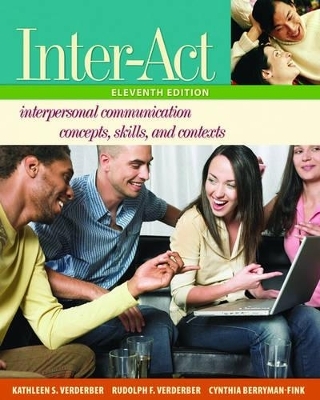
Inter-act
Oxford University Press Inc
978-0-19-530064-2 (ISBN)
- Titel erscheint in neuer Auflage
- Artikel merken
Designed to help students understand communication processes in relationships and develop specific skills needed to create and maintain healthy ones, the eleventh edition retains the features that have made this book so successful: a theory driven skills-based focus, an accessible tone and presentation, and numerous useful pedagogical tools. Cynthia Berryman-Fink, a new coauthor, brings fresh insights to this edition, which has a contemporary feel that will resonate with today's students and professors. Well-written and lively, Inter-Act features numerous activities that enable students to relate their everyday experiences to their studies in communication. The text illustrates how cultural, racial, and gender differences as well as electronically mediated messages alter what we should do to communicate effectively. It also emphasizes the importance of ethics in communication and encourages students to develop their analytical abilities as they think critically about the concepts presented in the text.
NEW OR REVISED IN THE ELEVENTH EDITION * New: Information on relational dialectics and turning points, coordinated management of meaning, the language of cyberspace, intergenerational family communication, and communicating in a diverse workplace. * New boxed features: "The Gray Zone" offers alternative viewpoints on aspects of interpersonal communication, while "Learn About Yourself" boxes provide students with short surveys to help them understand their own communication styles. * New: More than 50% of the "Diverse Voices" selections, "Inter-Act with Technology" boxes, and "What Would You Do? A Question of Ethics" boxes are new to this edition. * Expanded: The in-text CD now features a complete student workbook with chapter outlines, key terms lists, self-tests, quizzes, and numerous activities designed to help students master the material presented in each chapter. * Revised: The Instructor's Manual/Test Bank (available in both print and electronic versions) contains more effective teaching aids and additional test questions. Visit the companion website, www.oup.com/us/interact, which provides resources for both students and professors.
Each chapter ends with a Summary, Chapter Resources, Key Words, and Inter-Act with Media; Preface; PART 1: UNDERSTANDING INTERPERSONAL COMMUNICATION; 1. AN ORIENTATION TO INTERPERSONAL COMMUNICATION; Interpersonal Communication Defined; The Functions of Interpersonal Communication; Interpersonal Communication Components; Participant Characteristics and Roles; Context; Message Formation; Channels; Noise; Feedback Messages; Interpersonal Communication Principles; Interpersonal Communication Has Purpose; Interpersonal Communication Is Continuous; Interpersonal Communication Is Transactional; Interpersonal Communication Is Relational; Interpersonal Communication is Irreversible; The Ethics of Interpersonal Communication; Interpersonal Communication and Diversity; Diverse Voices: Arturo Madrid on Social Perception; Increasing Interpersonal Communication Competence; Spotlight on Scholars: Brian Spitzberg on Interpersonal Communication Competence; Understanding the Concepts and Developing the Skills that Lead To Competence; Super Skill: Behavioral Flexibility; Writing Communication Improvement Goal Statements; 2. FORMING AND USING SOCIAL PERCEPTIONS; The Perception Process; Attention and Selection; Organization of Stimuli; Interpretation of Stimuli; Perceptions of Self: Self-Concept and Self-Esteem; Forming and Maintaining a Self-Concept; Self-Monitoring; Developing and Maintaining Self-Esteem; Social Construction of Self; Spotlight on Scholars: Michael L. Hecht on Interethnic Communication and Ethnic Identity; Accuracy of Self-Concept and Self-Esteem; Self-Concept, Self-Esteem and Communication; Cultural and Gender Influences; Perception of Others; First Impressions; Perceptual Problems; Improving Accuracy of Social Perceptions; Communication Improvement Plan: Perception; 3. COMMUNICATING IN RELATIONSHIPS: BASIC CONCEPTS; Types of Relationships; Acquaintances; Friends; Close Friends or Intimates; Disclosure and Feedback in Relationships; Communication Patterns During Stages of Relationships; Spotlight on Scholars: Steven Duck on Personal Relationships; Beginning and Developing a Relationship; Maintaining a Relationship; Diverse Voices: Brenda J. Allen, Friendships that Bridge Differences; De-escalating and Dissolving a Relationship; Relational Dialectics; Autonomy-Connection; Openness-Closedness; Novelty-Predictability; Managing Dialectical Tensions; Turning Points in Relationships; Theoretical Perspectives on Relationships; Interpersonal Needs Theory; Exchange Theory; Communication Improvement Plan: Relationships; 4. VERBAL COMMUNICATION; Language and Perception; Sapir-Whorf Hypothesis; Polarized language; Language and Meaning; Symbolic Interactionism; Coordinated Management of Meaning; Language and Culture; Characteristics of Language; Improving Language Skills; Choose Specific Language; Adapt Language to Listeners; Date Information; Index Generalizations; Practice Communication Accommodation; Demonstrate Linguistic Sensitivity; Diverse Voices: Delores V. Tanno, I Am; Spotlight on Scholars: Molefi Kete Asante on The Language of Prejudice and Racism; Language in Unique Message Contexts; Language of Humor; Language of Cyberspace; Communication Improvement Plan: Verbal Communication; 5. COMMUNICATING THROUGH NONVERBAL BEHAVIORS; Characteristics and Functions of Nonverbal Communication; Types of Nonverbal Communication; Kinetics; Paralanguage; Vocal Interferences; Spatial Usage; Spotlight on Scholars: Judee K. Burgoon on Nonverbal; Expectancy Violation Theory; Artifacts; Self-Presentation Cues; Time; Olfactory Communication; Cultural and Gender Variations in Nonverbal Communication; Diverse Voices: Elizabeth Lozano, Latin American and; Anglo Use of Personal Space in Public Places; Improving Nonverbal Communication Skills; Sending Messages; Receiving Messages; Communication Improvement Plan: Nonverbal Communication; PART II: DEVELOPING INTERPERSONAL COMMUNICATION SKILLS; 6. HOLDING EFFECTIVE CONVERSATIONS; The Structure of Conversations; Beginning to Converse; The Body of a Conversation; Disengaging from Conversation; Characteristics of Conversations; Formality; Turn-Taking/Topic Change; Talk Time; Scriptedness; Conversational Audience; Rules of Conversations; Characteristics of Rules; The Cooperative Principle; Guidelines for Effective Conversationalists; Develop an Other-Centered Focus; Engage in Appropriate Turn-Taking; Maintain Conversational Coherence; Practice Politeness; Balance Appropriateness and Effectiveness; Protect Privacy; Cultural Variations in Conversations; Diverse Voices: Nancy Sakamoto, Conversational Ballgames Summary; Inter-Action Dialogue: Conversations; Communication Improvement Plan: Conversation; 7. LISTENING EFFECTIVELY; Attending; Understanding; Diverse Voices: Donal Carbaugh, I Can't Do That! But I Can Actually See Around Corners; Resist Taking Our Mind Off What the Speaker is Saying; Identify the Speaker's Purpose and Key Points; Observe Nonverbal Cues; Avoid Interrupting; Ask Questions; Paraphrase What You Heard; Remembering and Retaining Information; Spotlight on Scholars: Robert Bostrom on Listening; Repetition; Mnemonics; Note Taking; Critically Evaluating Information; Separate Fact from Inference; Probe for Information; Applying Skills to Listening in Cyberspace; Inter-Action Dialogue: Listening Effectively; Communication Improvement Plan: Listening; 8. SUPPORTING AND COMFORTING OTHERS; Empathy; Approaches to Empathy; Improving Our Ability to Empathize; Diverse Voices: Linda Howard, Black and White; Understanding Emotional Support; Supporting; Spotlight on Scholars: Brant Burleson on Comforting; Characteristics of Effective and Ineffective Emotional Support; Supportive Interaction Phases; Supportive Message Skills; Clarifying Supportive Intentions; Buffering Face Threats; Other-Centered Messages; Framing; Giving Advice; Social Support in Cyberspace; Gender and Cultural Differences and Similarities in Comforting; Inter-Action Dialogue: Responding and Comforting; Communication Improvement Plan: Responding; 9. SHARING PERSONAL INFORMATION: SELF-DISCLOSURE AND FEEDBACK; Self-Disclosure; Balancing Self-Disclosure and Privacy; Cultural and Gender Differences; Guidelines for Appropriate Self-Disclosure; Skills for Self-Disclosure and Privacy Management; Owning Feelings and Opinions; Describing Feelings; Masking Feelings; Displaying Feelings; Managing Privacy; Asking for Feedback; Giving Personal Feedback; Describing Behavior; Giving Constructive Criticism; Praising; Inter-Action Dialogue: Self-Disclosure; Communication Improvement Plan: Developing Relationships Through Self-Disclosure and Feedback; 10. USING INTERPERSONAL INFLUENCE ETHICALLY; Interpersonal Power in Relationships; Perception of Coercive Power; Reward power; Legitimate Power; Expert Power; Referent Power; Types of Persuasive Messages; Giving Good Reasons; Personal Credibility; Spotlight on Scholars: Richard Petty on Attitude Change; Emotion Appeals; Compliance-Gaining Strategies; Supporting-Evidence Strategies; Exchange Strategies; Direct-Request Strategies; Empathy-Based Strategies; Face-Maintenance Strategies; Other-Benefit Strategies; Distributive Strategies; Choosing a Strategy; Overcoming Resistance; Assertiveness; Contrasting Methods of Expressing Our Needs and Rights; Distinguishing Among Passive, Aggressive and Assertive Responses; Characteristics of Assertive Messages; Assertiveness in Cross-Cultural Relationships; Inter-Action Dialogue: Influence; Communication Improvement Plan: Influencing Ethically; 11. MANAGING CONFLICT; Types of Interpersonal Conflict; Pseudoconflict; Fact Conflict; Value Conflict; Policy Conflict; Ego Conflict; Styles of Managing Conflict; Withdrawal; Accommodating; Forcing; Compromising; Collaborating; Communication Patterns That Impede effective; Conflict Management; Ascribing Motives; Counter Blame; Demand-Withdrawal; Spiraling Negativity; Stubbornness; Communication Skills That Promote Successful Conflict Management; Spotlight on Scholars: Daniel J. Canary on Conflict Management; Communication Skills for Initiating Conflict; Communication Skills for Responding to Conflict; Communication Skills for Mediating Conflict; Diverse Voices: Mahboub Hashem, The Power of Wastah in Lebanese Speech; Recovering From Conflict Management Failures; Inter-Action Dialogue: Conflict; Communication Improvement Plan: Conflict Management; PART III: USING COMMUNICATION SKILLS TO IMPROVE RELATIONSHIPS; 12. COMMUNICATING IN INTIMATE RELATIONSHIPS: FRIENDS, SPOUSES, AND FAMILY; Characteristics of Intimate Relationships; Warmth and Affection; Trust; Self-Disclosure; Commitment; Types of Intimate Relationships and Relational Styles; Male Relationships; Female Relationships; Gender Differences in Intimacy; Male-Female Relationships; Marriage and Other Long-Term Committed Relationships; Spotlight on Scholars: Mary Anne Fitzpatrick on Couple Types and Communication; Family Relationships; Diverse Voices: Jacqueline Taylor, Performing Commitment; Intergenerational Family Communication; Improving Family Communication; Problems Associated with Intimacy; Loneliness; Relational Uncertainty; Jealousy; Sex-Role Stereotyping; Communication Improvement Plan: Intimate Relationships; 13. COMMUNICATING IN THE WORKPLACE; Presenting Yourself During the Hiring Process; Getting the Interview; Presenting Yourself During an Interview; Managing Relationships at Work; Communicating in Managerial Relationships; Communicating in Co-Worker Relationships; Communicating on a Work Team; Characteristics of Effective Work Teams; Communicating to Make Team Decisions; Leading Team Meetings; Diverse Voices: Delores Cathcart and Robert Cathcart, The Group: A Japanese Context; Member Responsibility in Team Meetings; Communicating in a Diverse Workplace; Organizational Romance; Sexual Harassment; Multicultural Based Work Style Differences; Inter-Generational Differences; Communication Improvement Plan: Workplace Communication; Index
| Erscheint lt. Verlag | 31.8.2006 |
|---|---|
| Co-Autor | Rudolph F. Verderber, Cynthia Berryman-Fink |
| Zusatzinfo | 94 illustrations |
| Verlagsort | New York |
| Sprache | englisch |
| Themenwelt | Sozialwissenschaften ► Kommunikation / Medien ► Journalistik |
| Sozialwissenschaften ► Kommunikation / Medien ► Kommunikationswissenschaft | |
| Wirtschaft | |
| ISBN-10 | 0-19-530064-5 / 0195300645 |
| ISBN-13 | 978-0-19-530064-2 / 9780195300642 |
| Zustand | Neuware |
| Haben Sie eine Frage zum Produkt? |
aus dem Bereich

